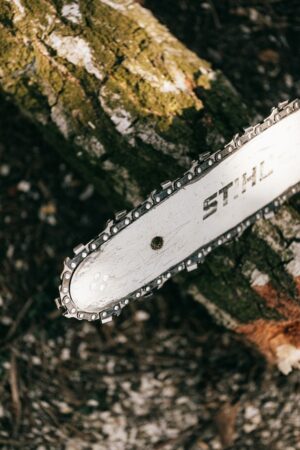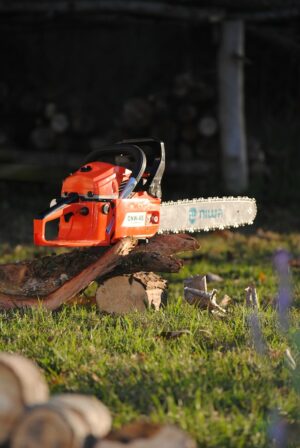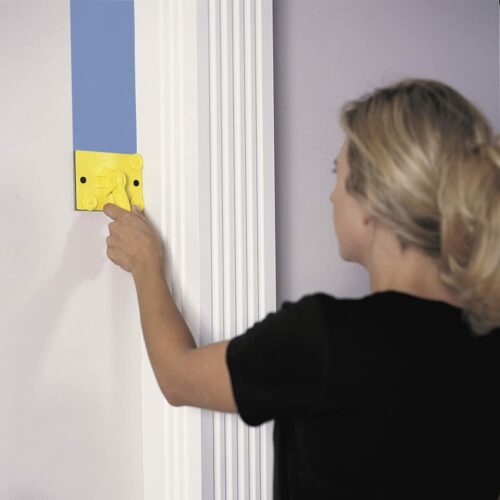Chainsaw chain tension is a hot topic of discussion. How tight should they be? Some contend that they ought to be quite tight to ensure that the chain is secured as firmly as possible.
Others feel that the chain should be somewhat slack to allow for greater mobility.
Who then is correct?
Continue reading to learn more about chainsaw chain tensioning and how tight a chainsaw chain should be.
What is the ideal chainsaw chain tension?
Keep your chainsaw chain “snap-tight,” as the pros would say. That is to say, while the chainsaw is not operating, the chain should be so tight that you can hardly move it by hand. However, it shouldn’t be so loose that you can pull it out of the guides on the bar’s edge.
When the chainsaw chain is loose, the chainsaw may vibrate excessively and it may even come off the handle as you use it.
On the other side, if the chain is excessively tight, the motor will be overworked and cutting will be challenging.
Chainsaw chains should be tensioned such that they are neither too loose nor too tight, but instead fall in the middle of the two ranges.
Trying to push the chainsaw chain with your finger is the best way to determine whether it is sufficiently tight. It’s too loose if you can make it move. It’s too tight if you can’t move it at all. (Complete this before turning on the chainsaw.)
Before each use, you should also make sure the chainsaw’s chain is properly tensioned. This is due to the chain eventually requiring tightening as it stretches over time.
Consult your owner’s handbook or take your chainsaw to a professional for assistance if you’re unsure how to acquire the correct chain tension.

Table of Contents
Monitoring the chainsaw’s tension
If you don’t take care of your chainsaw chains properly, a lot of things can go wrong. Chainsaw chain tension is one of the most crucial things to monitor.
While using the saw, the chain could come off if it is too slack. Too much tightness could harm the saw. So how do you determine how tight to create a chainsaw chain and how much strain is too much?
Different Chain Tensions
With a chainsaw chain, there are two forms of tension to be mindful of: static tension and dynamic tension.
When the saw is not being used or idle, static tension prevents the chain from coming off. The chain is kept tight while the saw is operating thanks to dynamic tension.
How to Check the Tension of a Static Chain
By using a tension screw to remove the chain from the bar tip while the saw is not operating, you can check the static chain tension of your chainsaw.
If it comes off easily, the chain tension is too loose, and the chain bar adjustment needs to be tightened. If you are completely unable to pull it off, the tension is too tight and needs to be released.
Performing Dynamic Chain Tension Testing
A chainsaw file is the most effective tool for measuring dynamic chain tension. On the top side of the chainsaw chain, follow the cutting teeth with the file.
The dynamic tension needs to be changed if there are any locations where the file catches or becomes stuck.
Generally speaking, you want the chainsaw to be tight enough so that there is no possibility of it coming off, but not too tight so that the motor gets overworked.
It’s usually wise to err on the side of caution and choose a tighter chain if you’re unsure. If the chain comes off in the middle of a cut, there isn’t much you can do. However, you can always loosen the chain if necessary.
Some Advice To Increase Chainsaw Chain Life

If you want your chainsaw chains to last, it’s critical to maintain good condition. Here are some pointers for extending the chainsaw’s life:
Maintain Proper Depth Gauges Settings.
It is possible for the chainsaw chains to ride too high or low on the bar as a result of improperly calibrated depth gauges, which could harm both the bar and the chains.
Regularly clean and lubricate.
A chainsaw chain that is well-maintained and properly greased will function better and last longer than one that is neglected and will result in a chain brake.
Don’t cut with excessive force.
Leave the work to the chainsaw bar. The chain and the bar might be harmed by pushing too forcefully.
Use the chainsaw only for the purposes for which it was intended.
Avoid using your chainsaw to cut through metal or nails, for instance. This will harm the chain and potentially result in severe injury.
Maintain The Chain’s Edge.
The saw will have to work harder and could experience kickbacks if the chain is dull. Keep the chain sharp at all times.
These easy recommendations will help you keep your chainsaw chain in good condition for many years to come.
Testing Chainsaw Chain Tension
A chainsaw user can check the tension of their chain in one of two ways:
Calculate the distance between the chain and the bar’s bottom.
Your chain has to be tightened if there is room for more than three fingers between the bar and the chain.
Your chain may be too tight and has to be relaxed if you can only fit one finger or less in it. When two fingers can fit between the chain and the guide bar rail, the chain is at the proper tension.
What happens if the chain on my chainsaw is too tight or loose?
While you are using a chainsaw, a chain that is poorly fitted could come off and seriously hurt you. Your chainsaw’s motor may experience unnecessary strain and possible early wear and tear if the chain is too tight.
It is crucial to frequently check your chainsaw’s tensioning pin, confirm that it is set correctly, and make any necessary adjustments. Depending on how frequently you use your chainsaw and the type of wood you are cutting, you may need to do this more frequently.
You will need to check and adjust the tension by the chain tensioner pin more regularly if you frequently use your chainsaw to cut wood than if you only use it infrequently or exclusively cut softwood.
Consult the owner’s manual for your specific model if you’re unsure how to tighten your chainsaw chain properly, or ask a pro for help.
With a little practice, you will be able to quickly and simply verify whether the chainsaw’s tension is incorrect and maintain it so that it is operating at peak efficiency.
It’s time to use your newfound knowledge of how to correctly tension chainsaw chains by going outside and using them.



